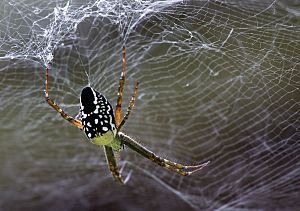Tent-web spiders facts for kids
Quick facts for kids Tent-web spider |
|
|---|---|
 |
|
| Green tent-web spider | |
 |
|
| Cyrtophora moluccensis suspended beneath its web | |
| Scientific classification |
|
| Kingdom: | Animalia |
| Phylum: | Arthropoda |
| Subphylum: | Chelicerata |
| Class: | Arachnida |
| Order: | Araneae |
| Infraorder: | Araneomorphae |
| Family: | Araneidae |
| Subfamily: | Cyrtophorinae |
| Genus: | Cyrtophora Simon, 1864 |
| Type species | |
| C. citricola (Forsskål, 1775)
|
|
| Species | |
|
53, see text |
|
| Synonyms | |
|
|
Cyrtophora, also known as tent-web spiders, are a type of spider first described by Eugène Simon in 1895. Even though they belong to the "orb-weaver" family, they don't actually build the typical round, flat orb webs you might imagine. Instead, they create unique, tent-shaped webs that are very complex and not sticky. These special webs are often built horizontally, with many supporting threads above them to hold them up.
These spiders often live together in groups, forming colonies. Female tent-web spiders are usually about 10 millimeters (about 0.4 inches) long. Some species, like Cyrtophora cicatrosa, can even change their color quickly to blend in with their surroundings!
Some tent-web spiders have an interesting relationship with other spiders. For example, a spider called Argyrodes fissifrons sometimes lives in the webs of Cyrtophora species. They share the space and perhaps even some food. Some Cyrtophora species are also known as "social spiders." This means they build very large shared web structures where the young spiders create their own smaller territories along the edges of their mother's web.
Spider Species
As of 2019, there are fifty-three known species of Cyrtophora spiders. These spiders are found in many different parts of the world, including Asia, Africa, and Australia. Each species has its own unique features and habitats.

